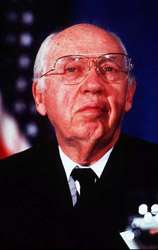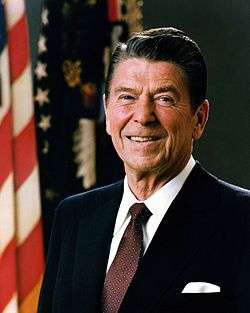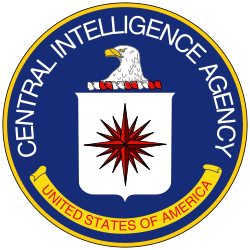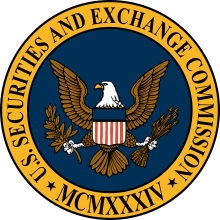William J. Casey
| William J. Casey | |
|---|---|
 | |
| Director of Central Intelligence | |
|
In office January 28, 1981 – January 29, 1987 | |
| President | Ronald Reagan |
| Deputy |
Frank Carlucci Bobby Ray Inman John N. McMahon Robert Gates |
| Preceded by | Stansfield Turner |
| Succeeded by | William H. Webster |
| Under Secretary of State for Economic Growth, Energy, and the Environment | |
|
In office February 2, 1973 – March 14, 1974 | |
| President |
Richard Nixon Gerald Ford |
| Preceded by | Thomas C. Mann |
| Succeeded by | Charles W. Robinson |
| Chair of the Securities and Exchange Commission | |
|
In office April 14, 1971 – February 2, 1973 | |
| President | Richard Nixon |
| Preceded by | Hamer H. Budge |
| Succeeded by | G. Bradford Cook |
| Personal details | |
| Born |
William Joseph Casey March 13, 1913 New York City, New York, U.S. |
| Died |
May 6, 1987 (aged 74) Roslyn Harbor, New York, U.S. |
| Political party | Republican |
| Alma mater |
Fordham University St. John's University, New York |
| Religion | Roman Catholicism |
William Joseph Casey (March 13, 1913 – May 6, 1987) was the Director of Central Intelligence from 1981 to 1987. In this capacity he oversaw the entire United States Intelligence Community and personally directed the Central Intelligence Agency (CIA).
Life and career
A native of Elmhurst, Queens, New York, Casey graduated from Fordham University in 1934 and earned a law degree from St. John's University School of Law in 1937. His portrait now sits in Molloy College. During World War II, he worked for the Office of Strategic Services (OSS) — the predecessor to the CIA — where he became head of its Secret Intelligence Branch in Europe.[1] He was awarded the Bronze Star Medal for meritorious achievement. The OSS was dissolved in 1945.
Casey ran as a Republican for New York's 3rd congressional district in 1966, but was defeated in the primary by former Congressman Steven Derounian.[2] After practicing corporate law in New York, he served in the Nixon Administration as the chairman of the Securities and Exchange Commission from 1971 to 1973;[3] this position led to his being called as a prosecution witness against former Attorney General John N. Mitchell and former Commerce Secretary Maurice Stans in an influence-peddling case stemming from international financier Robert Vesco's $200,000 contribution to the Nixon reelection campaign.[4] He then served as Under Secretary of State for Economic Affairs for 1973-74 and chairman of the Export-Import Bank of the United States 1974-76. He was a co-founder of the Manhattan Institute in 1978. He is the father-in-law of Owen Smith, Chairman of the Board of Trustees of the Institute of World Politics and Professor Emeritus at Long Island University.[5]
Director of Central Intelligence
Casey was campaign manager of the successful presidential campaign of Ronald Reagan in 1980, and served on the transition team following the election. After Reagan took office, Reagan named Casey to the post of Director of Central Intelligence.[6] Stansfield Turner dubbed it the "Resurrection of Wild Bill", referring to Bill Donovan, the brilliant and eccentric head of OSS in World War II whom Casey greatly admired.[7]
Ronald Reagan used prominent Catholics in his government to brief the pope during the Cold War. Casey would fly secretly to Rome in a windowless C-141 black jet and "be taken undercover to the Vatican.[8]
Casey oversaw the re-expansion of the Intelligence Community to funding and human resource levels greater than those existing before the preceding Carter Administration; in particular, he increased levels within the CIA. During his tenure, restrictions were lifted on the use of the CIA to directly and covertly influence the internal and foreign affairs of countries relevant to American policy. Notably, Casey articulated before Congress in December 1981 that covert operations in Nicaragua were in the interest of national security.[9]
This period of the Cold War saw an increase in the Agency's global, anti-Soviet activities, which is started under the Carter Doctrine in late 1980.
Iran–Contra affair
The day before Casey was scheduled to testify before Congress related to his knowledge of the Iran–Contra affair, Casey suffered two seizures and was hospitalized. Three days later, Casey underwent surgery for a previously undiagnosed brain tumor.[1]
In a 1987 book, Veil: The Secret Wars of the CIA 1981-1987, Washington Post reporter and biographer Bob Woodward, who had interviewed Casey on a number of occasions for the biography, said that he had gained entry into Casey's hospital room for a final, four-minute encounter—a claim which was met with disbelief in many quarters as well as an adamant denial from Casey's wife, Sofia. According to Woodward, when Casey was asked if he knew about the diversion of funds to the Nicaraguan Contras, "His head jerked up hard. He stared, and finally nodded yes."[10] Independent Counsel, Lawrence Walsh wrote: "Independent Counsel obtained no documentary evidence showing Casey knew about or approved the diversion. The only direct testimony linking Casey to early knowledge of the diversion came from [Oliver] North."[11]
Personal life
Casey, a Catholic, was a member of the Knights of Malta.[12]
Death
Casey died of a brain tumor on May 6, 1987 at the age of 74. His Requiem Mass was said by Fr. Daniel Fagan, then pastor of St. Mary's Roman Catholic Church in Roslyn, New York. It was attended by President Reagan and the First Lady. Casey is buried in the Cemetery of the Holy Rood in Westbury, New York. He was survived by his wife, the former Sophia McDaid (d.2000), and his daughter, Bernadette Casey Smith.[13]
See also
References
- 1 2 Pace, Eric (May 7, 1987). "Obituary of Mr William Casey". New York Times.
Mr. Casey, after serving as chief of secret intelligence in Europe for the Office of Strategic Services in World War II,
- ↑ Wolfgang Saxon (April 20, 2007). "Steven B. Derounian, 89, Judge and Nassau Ex-Congressman, Dies". New York Times.
- ↑ Nomination of William J. Casey: Hearings, Ninety-second Congress, first session, on the nomination of William J. Casey to be a member of the Securities and Exchange Commission. February 10 and March 9, 1971.
- ↑ Woodward, Bob (1987). VEIL: The Secret Wars of the CIA 1981-1987. New York: Simon and Schuster. p. 51.
- ↑ http://www.iwp.edu/about/page/board-of-trustees
- ↑ Nomination of William J. Casey: Hearing Before the Select Committee on Intelligence, of the United States Senate, Ninety-seventh Congress, First Session, on Nomination of William J. Casey, to be Director of Central Intelligence, Tuesday, January 13, 1981, Volume 4.
- ↑ Burn Before Reading, Stansfield Turner, Hyperion, 2005, first page of chapter on Ronald Reagan
- ↑ Officials say pope, Reagan shared Cold War data, but lacked alliance, Catholic News Service, Nov-17-2004
- ↑ Webb, Gary (1999). Dark Alliance. Seven Stories Press. p. 74. ISBN 978-1-888363-93-7.
- ↑ "Did A Dead Man Tell No Tales?" by Richard Zoglin, Time, October 12, 1987
- ↑ https://fas.org/irp/offdocs/walsh/chap_15.htm
- ↑ Phelan, Matthew (2011-02-28) Seymour Hersh and the men who want him committed, Salon.com
- ↑ On October 5, 2000, of Roslyn Harbor. Beloved wife of the late William J. Casey, former Director of Central Intelligence. Loving mother of Bernadette Casey Smith, The New York Times, October 9, 2000
- Joseph E. Persico. Casey: The Lives and Secrets of William J. Casey-From the Oss to the CIA (1991)
- Casey was featured prominently in Bob Woodward's book Veil: The Secret Wars of the CIA (ISBN 0-671-60117-2).
- Casey's role in the Afghanistan War in Steve Coll's book Ghost Wars: The Secret History of the CIA, Afghanistan, and Bin Laden, From the Soviet Invasion to September 10, 2001 (ISBN 1-59420-007-6).
External links
| Government offices | ||
|---|---|---|
| Preceded by Hamer H. Budge |
Chair of the Securities and Exchange Commission 1971–1973 |
Succeeded by G. Bradford Cook |
| Preceded by Stansfield Turner |
Director of Central Intelligence 1981–1987 |
Succeeded by William H. Webster |
| Political offices | ||
| Preceded by Thomas C. Mann |
Under Secretary of State for Economic Growth, Energy, and the Environment 1973–1974 |
Succeeded by Charles W. Robinson |


